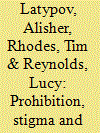|
|
|
Sort Order |
|
|
|
Items / Page
|
|
|
|
|
|
|
| Srl | Item |
| 1 |
ID:
119509


|
|
|
|
|
| Publication |
2013.
|
| Summary/Abstract |
As in other countries of Central Asia, HIV infections in Kyrgyzstan have increased steeply in recent years, driven by factors such as the sharing of drug paraphernalia among injecting drug users, sex work and other risky sex behaviours, prison settings and infections acquired in hospitals. In contrast to its neighbours, Kyrgyzstan has long been considered a regional pioneer in its response to the HIV/AIDS epidemic, displaying political will and strong leadership, a timely response, and a multi-sectoral approach to tackle the disease. Yet this progress has become increasingly difficult to sustain in recent years, as it has been undermined by political and social instability, the reorganization of the Country Coordinating Committee to fight HIV/AIDS, Tuberculosis and Malaria, the lack of unified mechanisms for data collection, monitoring and evaluation, a high rate of turnover of senior and mid-level staff, stigma and discrimination faced by those most at risk, and heavy dependence on external donors.
|
|
|
|
|
|
|
|
|
|
|
|
|
|
|
|
| 2 |
ID:
119507


|
|
|
|
|
| Publication |
2013.
|
| Summary/Abstract |
This article discusses spiritual healing in post-Soviet Kazakhstan with reference to changing discourses about 'shamanic illness': a condition that afflicts the future healer. What had traditionally been identified as the call of spirits was seized in the Soviet period by biomedical discourse which ascribed those symptoms to mental illness. Whereas this attitude also influenced popular understandings of 'shamanic illness' at the time, traditional ideas have been gradually restored in the context of the political and social changes of the 1990s. Biomedical discourse on 'shamanic illness' has also undergone significant changes. I argue that this was induced by multiple interconnected factors, among which are the reappraisal and support of the government for Kazakh 'folk' medicine as a part of the national heritage, and a favourable attitude to local, traditional forms of religiosity. This allowed for collaboration between doctors and healers in the context of institutionalization of traditional medicine. Alongside these influences the strength of the tradition of remembering the spirits of ancestors prompted the re-establishment of this core experience in the process of becoming a healer: the call of spirits.
|
|
|
|
|
|
|
|
|
|
|
|
|
|
|
|
| 3 |
ID:
119505


|
|
|
|
|
| Publication |
2013.
|
| Summary/Abstract |
This article surveys the body of medical literature, in Arabic, Persian and Turkic, produced and circulated in Central Asia from the sixteenth to twentieth centuries, on the basis of catalogues of Islamic manuscript collections in the region, highlighting royal patronage of medical knowledge as well as the continuation of traditional modes of transmitting medical lore into the colonial and Soviet periods. The survey is a reminder that indigenous medical lore in Central Asia left a substantial body of still-unexplored sources, and that the encounter of traditional Central Asian medical practices with 'modern' medicine cannot reasonably be studied solely on the basis of Russian colonial or Soviet perspectives.
|
|
|
|
|
|
|
|
|
|
|
|
|
|
|
|
| 4 |
ID:
119506


|
|
|
|
|
| Publication |
2013.
|
| Summary/Abstract |
This article provides an overview of drug consumption in the Pamirs in the late nineteenth and early twentieth centuries and examines the evolution of the early Soviet responses to opium smoking in Soviet Badakhshan on the basis of published literature, archival materials, oral histories and medical records. The author demonstrates that biomedicine remained significantly underdeveloped in that region during the first decades of Soviet rule, with central and local authorities relying on punitive and restrictive administrative measures in their fight against drug addiction. As these measures failed to wipe out opiate addiction in Gorno-Badakhshan, the opium war at the 'roof of the world' culminated in the Great Terror, providing the Stalinist regime with the 'radical' solution by liquidating drug dealers without any 'show trials' and incarcerating opiate consumers. The consequences of such administrative regulation of addiction in Soviet Badakhshan were dire: in the years between 1941 and 1968, only few patients with the diagnosis of narkomania were hospitalized in the Tajik Republican Psychiatric Hospital, while the exact numbers of repressed drug users who perished in prisons and Gulag camps are destined to remain unknown.
|
|
|
|
|
|
|
|
|
|
|
|
|
|
|
|
| 5 |
ID:
119508


|
|
|
|
|
| Publication |
2013.
|
| Summary/Abstract |
Conscious of a paucity of evidence, and drawing upon a combination of historical documentary material, research literature and surveillance data, this paper offers a commentary on the social, historical and HIV contexts affecting men who have sex with men in Central Asia. The authors describe the history of men who have sex with men in the five Central Asian republics, before, during and after the Soviet-imposed legal prohibition, which continues in Turkmenistan and Uzbekistan, the only nations in the World Health Organization Europe region where sex between men remains illegal. This historical context frames contemporary responses to men who have sex with men. Despite long-established homoerotic traditions, modern attitudes to men who have sex with men are marked by great hostility, generating stigmatization of sex between men and discrimination against men suspected of it. The losses following public exposure can be severe: loss of employment; limited/lack of health-care access; and safety from physical and sexual assault. Such hostility creates an environment of increased HIV risk, and constrains the production of reliable HIV evidence. The authors argue that the generation of HIV risk, HIV-prevention responses and HIV evidence are products of their historical and social contexts, and call attention to the urgent need for HIV prevention and structural reforms to protect the health of men who have sex with men in Central Asia.
|
|
|
|
|
|
|
|
|
|
|
|
|
|
|
|
|
|
|
|
|